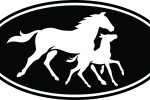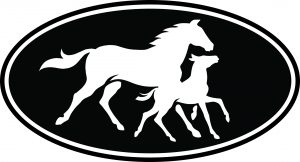By James Crowhurst, MA VetMB MRCVS
New arrivals
Colts retiring from training have been kept away from fillies and even actively restrained from demonstrating their libido during training (the use of stallion rings has virtually ceased). A good clinical examination on arrival, including an assessment of his genital organs, is essential. It may not have been possible to collect proper swabs for venereal diseases at the vetting for purchase if it was done during training, so these should be done on arrival if possible under sedation or, even better, after gentle teasing education.
Virgin stallions can carry venereal pathogens such as Pseudomonas and Klebsiella, in fact (as with mares) are more likely to than sexually active ones. As both can be difficult to eliminate and are bad for the horse’s early experience of teasing, urgent detection and treatment is of the essence. Similarly, bloods test results, particularly for EVA and EIA, should be checked.
First season
Gentle teasing with a quiet mare, well in season, not stitched and properly swabbed should be undertaken before the breeding season and will help each horse to know what is ‘allowed’. This should lead on to some trial matings. It is so helpful to have something pregnant at the start of the breeding season to instil confidence as the season starts properly.
Dismount samples can indicate the presence or activity of sperm, but semen collection via artificial vagina is not advised until natural mating behaviour has been established. At no time is experienced horse handling more important than in a stallion’s first season – the early handling may have long-lasting consequences for good or ill.
Low libido
Most stallions learn their new job very quickly, needing only guidance and boundaries of behaviour. Signs of low libido include indifference, non-vocalisation, non- or part erection, and non-mounting. All stallions belong to dominant ‘harem’ or ‘bachelor’ groupings in the wild and this is true when housed with others. Therefore, shy bachelor ones may need to be housed separately from other stallions and in some cases held loosely on a long lungeing rein attached to a head collar only, no bridle, is preferable, to gain confidence when learning to cover mares.
Variation of the in-season mare, surroundings and handler should be tried, and being stabled next door to quiet in-season mares, away from other stallions, may help. Generally, patient application of these variables will achieve success, and real failures will need an in-depth veterinary investigation, including analysis of sex hormones such as testosterone and inhibin.
Physical problems, including back and hind leg lamenesses, may affect mounting and ejaculation (the author has recently been involved with two stallions, one young and one old, both with significant stifle cartilage damage, one if not both definitely resulting from a fall).
Any colt or stallion recovering from injury or disease may need controlled teasing/mounting to prepare for full breeding duties. Unfortunately the season often starts ‘with a bang’, with maximum covering slots booked in the first two weeks. Horses should be fit, both cardiovascularly and skeletally.
Preparation for season
Assuming that all tests to fulfil Code of Practice requirements are in order, each stallion needs to be prepared:
Exercise A combination of walking and occasional regular lungeing is considered optimal to improve fitness of circulation and skeleton. All bones lose calcium if not exercised, so limbs and joints need regular exercise, starting at least two months before the season. This will help reduce any unnecessary weight/improve fluid intake.
Diet
This may need to increase with the reduction of available grass in winter and increasing exercise. Diets rich in Omega 3 oils are believed by some to aid fertility, but the addition of oils rich in these on a daily basis can be a cost effective way of achieving this. Anything that may assist horn growth and quality, e.g. Vitamin E and selenium may be added if the horse’s feet are sub-optimal.
Light
Stallions are seasonal breeders, like mares, and extra light has been shown to bring forward their natural season (testicular size and semen production will vary within and between seasons). Stallions with marginal fertility/testicular volume might be helped by such programmes.
How many mares?
All stallions have a number of mares that they can comfortably manage with normally ‘good’ fertility levels, as mares are managed increasingly effectively. A lot is taken for granted nowadays, with some stallions covering more than a hundred mares in two breeding seasons each year, figures that would have been ridiculed many years ago. There is no pleasure seeing stallions being asked to work ‘outside their comfort zone’, and a reduction in mare numbers may lead to increased numbers of mares conceiving. Careful analysis of statistics will illuminate patterns. A fourth cover in a day, however good the libido, may be completely unsuccessful and therefore wasted.
Semen production is directly proportional to testicular volume and the latter can be measured accurately with an ultrasound scanner. Large testicular volume will not guarantee high fertility and libido, but will give an idea of potential. Again, careful observation and management, especially at covering, will assist the stallion manager with workload and scheduling. Large AI programmes collect only twice weekly, as further collections do not lead to increase sperm numbers being available for insemination.
Problems
In first-season stallions, failure to achieve conceptions to start with is alarming but may not be permanent. Some may not be ejaculating – easily identified by observation or dismount sampling. Some may be ‘plugged’ i.e. have their epididymis blocked by a combination of old sperm and seminal fluid aggregations. These may be identified by ultrasound scanning and may need covering practice to help clear them before the season.
Certainly, complete fertility failure is rare and needs thorough veterinary investigation. It is usually, though not always, diagnosed by semen evaluation. Very rarely we have seen instances of perfect semen, even looked at under electron microscopy, fail to achieve any conceptions. The number of normal, progressively motile sperm is an important part of any semen evaluation. Careful reading of the terms of any first-season fertility insurance is essential to make sure that the horse fulfils all their requirements to validate a claim. The small print here is important.
Semen production in the testis takes two months from start to finish so any interruption to the process necessitates at least this time to recover. The production of sperm is affected by many things, in particular heat, some drugs and illnesses. Any general fever in a stallion can be catastrophic for semen production if high or long lasting enough, even though the testes are kept ‘outside’ the body to maintain a cooler temperature than internal organs. It is for this reason that true rigs are not fertile.
Trauma
Stallions are at their most vulnerable when covering and can do little to protect themselves. Even with good teasing and protective boots on mares’ hind feet, stallions can get kicked and their genital organs are poorly protected (very thin skin) and highly vascular (needing significant blood volume to achieve erection).
All kick or traumatic wounds to penis or genital area need immediate local and parenteral treatment to reduce swelling, pain and possible infection. Resultant heat
and insulation from swelling may affect sperm production, even after he appears to have recovered.
Drugs
It is well known that anabolic steroids used in young colts can lead to temporary or permanent infertility later. Other drugs, like ACP, carry specific warnings that they are not to be used in breeding stallions. Long term use of non-steroidal anti-inflammatory drugs such as bute can be deleterious. Also, the use of cortico-steroids, especially in depot form, can trigger laminitic episodes and must be used with great caution.
Disease
As previously mentioned, any febrile episode can be dangerous. In addition there can be venereal diseases which are not necessarily febrile, such as bacterial diseases like CEM, Pseudomonas and various capsule types of Klebsiella. Mostly, affected stallions and mares will not show any symptoms, but fertility will fall and mares may show vaginal discharge a few days after covering.
Some of these infections can be hard to eliminate, as much washing and dressing of genital organs is required. Second, viral diseases like EVA may also be asymptomatic and a proportion of stallions that contract EVA will, despite all treatment, remain shedders for life and would not be helped by AI. Strict adherence to the Code of Practice is essential as the threat of importing more serious exotic diseases does not decrease. Jet Master died of West Nile Virus in South Africa earlier this year.
Laminitis remains a significant cause of death in stallions of all ages. There are several reasons for this. First, some stallions are allowed to get overweight and don’t have enough exercise. Pre-season walking and occasional lungeing is important as previously stated.
Second, in uncastrated males, many stallions will develop a crest which is not all fat, despite keeping them in a good, not overweight bodily condition. This crest adds extra pressure on the front legs and feet, acting as a cantilever which is supported only at one end.
Third, stallions are prone to Cushings Disease, a benign tumour of the pituitary gland that affects the horse’s own steroids, leading to many different problems as well as a long hairy coat. This disease can be successfully treated once recognised, but affected stallions will often respond poorly to normal treatments for laminitis or relapse quickly. Prophylactic blood tests for Cushings Disease are sensible in aged stallions, despite apparent good health.
Other problems
Sperm are very sensitive to abnormal conditions in semen and any blood, infection or urine can reduce fertility. Careful examination of the horse and his routine before and at covering has often revealed one of these and been simply rectified by a change of management and/or treatment.
Gold standard stallion management
1. Stallions are creatures of habit. They like a routine and a small number of handlers. Good, sensible horsemanship is paramount.
2. Take his temperature daily and record it, as some fevers can go unnoticed.
3. Weigh him weekly and record it, to signal excessive weight gain or unexplained weight loss.
4. Good preparation for the breeding season, with graded exercise starting at least two months before. A combination of daily walking/ridden and occasional lungeing.
5. Good observation of the feet, especially in front. Horses’ feet benefit from having shoes removed, at least for part of the year, and any deterioration in foot pastern angle, horn quality or action should be investigated. Don’t rely on the farrier completely!
6. Shuttle stallions seem to cope with two springs, but should be allowed adequate rest periods between seasons.



